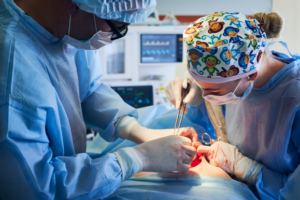Dr.Satish C- Head and neck cancer surgeon in Gottigere
Mandibulectomy (Marginal /Segmental /Hemi)
Mandibulectomy is one of the common surgical treatment options recommended for cancers of the mouth and jaw.

Mandibulectomy (Marginal /Segmental /Hemi)
Overview
This procedure removes the lower jaw or mandible completely or in part to stop cancer cells from spreading. This procedure may be recommended for both non-cancerous and cancerous tumors.

More about Mandibulectomy (Marginal /Segmental /Hemi)
There are different types of mandibulectomy recommended by Head and neck cancer surgeon in Gottigere | Dr. Satish C based on the stage of the disease.
- Total Mandibulectomy: Total mandibulectomy is a procedure where the entire mandible, along with the bilateral disarticulation, is removed.
- Partial Mandibulectomy: This procedure involves the removal of only a portion of the mandible while leaving the unaffected part intact. Partial mandibulectomy is further classified into:
- Marginal mandibulectomy: Marginal mandibulectomy only removes cancerous tissue. As the majority of the jaw is still present, no reconstructive surgery is necessary.
- Segmental mandibulectomy: This procedure removes the entire jaw, and this may or may not include the jaw joint. This procedure is often followed by reconstructive surgery. During reconstruction, bone flap is taken from the leg, back, arm, or hip to build a new jaw.
- Hemi Mandibulectomy: Hemi mandibulectomy refers to the surgical removal of the lateral half of the mandible.
Mandibulectomy is one such surgical procedure that needs utmost precision and care, and for this reason, it is important for patients to consult a surgeon with robust expertise and experience. If you are looking for the best mandibulectomy surgeon, you may consult Dr. Satish C, who has more than 7 years of experience in the surgical management of head and neck cancers.
How is Mandibulectomy Performed?
The patient is put under general anesthesia. Surgery may be done through the mouth (transorally) or by making an incision on the skin, depending on the size of the tumor. If metastasis to nearby lymph nodes is suspected, then neck dissection may be recommended too. The surgeon might choose to perform a tracheostomy if there’s a risk of airway swelling.
In some cases, free flap reconstruction follows the mandibulectomy. During this procedure, the jaw portion that has been removed will be replaced with the patient’s own muscles, skin, or bone flaps and metal plates. Reconstruction surgery plays a pivotal role in restoring the patient’s ability to eat, chew, swallow, and speak. Additionally, in some cases, patients may also need dental restoration. Rehabilitation support can positively impact the recovery of these patients.
Frequently Asked Questions
This entirely depends on the type of cancer, exact location, and stage of the disease. In some cases, mandibulectomy may be recommended in combination with other treatments like chemotherapy and radiotherapy. You must talk to your doctor for more information on the right treatment for your condition.
Surgeons always ensure that mandibulectomy is always safely performed, and patients experience no side effects after the procedure. However, on rare occasions, patients may experience side effects like bleeding, infection, salivary fistula, changes in tooth alignment, difficulty in opening the mouth, nerve damage, speech and swallowing difficulties, numbness, etc. These side effects are temporary in most cases, and can be managed successfully.
This depends on the type of mandibulectomy that you have undergone. In the case of marginal mandibulectomy, a reconstruction may or may not be required. However, in the case of segmental mandibulectomy, reconstruction surgery is required as the jaw bone is discontinuous.
This largely depends on the type of mandibulectomy you’ve undergone. Patients recover at a relatively faster rate with marginal mandibulectomy. Also, opting for appropriate follow-up care and rehabilitation care can support faster recovery.
Doctors use multimodal treatment approaches in order to avoid recurrences. However, in some cases, cancer can come back after mandibulectomy, and it can be treated effectively. It is for this reason you should not miss your follow-up appointments after your treatment.
Dr. Satish C has vast experience in administering surgical interventions for head and neck cancers. He is the best doctor for mandibulectomy in Bangalore.